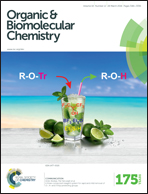Four new carbazole alkaloids from Murraya koenigii that display anti-inflammatory and anti-microbial activities†
Abstract
In our present study, four new, designated as murrayakonine A–D (1–4), along with 18 known carbazole alkaloids were isolated from CHCl3 : MeOH (1 : 1) crude extracts of the stems and leaves of Murraya koenigii (Linn.) Spreng. The structures of the all isolated compounds were characterized by analysis of HR-ESI-MS and NMR (1D and 2D spectroscopy) results, and comparison of their data with the literature data. For the first time, all the isolates were evaluated for their anti-inflammatory activities, using both in vitro and in vivo experiments, against the key inflammatory mediators TNF-α and IL-6. The new compound murrayakonine A (1), O-methylmurrayamine A (13) and mukolidine (18) were proven to be the most active, efficiently inhibiting TNF-α and IL-6 release in a dose-dependent manner and showing decreased LPS induced TNF-α and IL-6 production in human PBMCs. Furthermore, all the isolates were screened for their antimicrobial potential, and the compounds girinimbine (12) (IC50 3.4 μM) and 1-hydroxy-7-methoxy-8-(3-methylbut-2-en-1-yl)-9H-carbazole-3-carbaldehyde (19) (IC50 10.9 μM) displayed potent inhibitory effects against Bacillus cereus. Furthermore, compounds murrayamine J (7) (IC50 11.7 μM) and koenimbine (14) (IC50 17.0 μM) were active against Staphylococcus aureus. However, none of the compounds were found to be active against Escherichia coli or Candida albicans.


 Please wait while we load your content...
Please wait while we load your content...